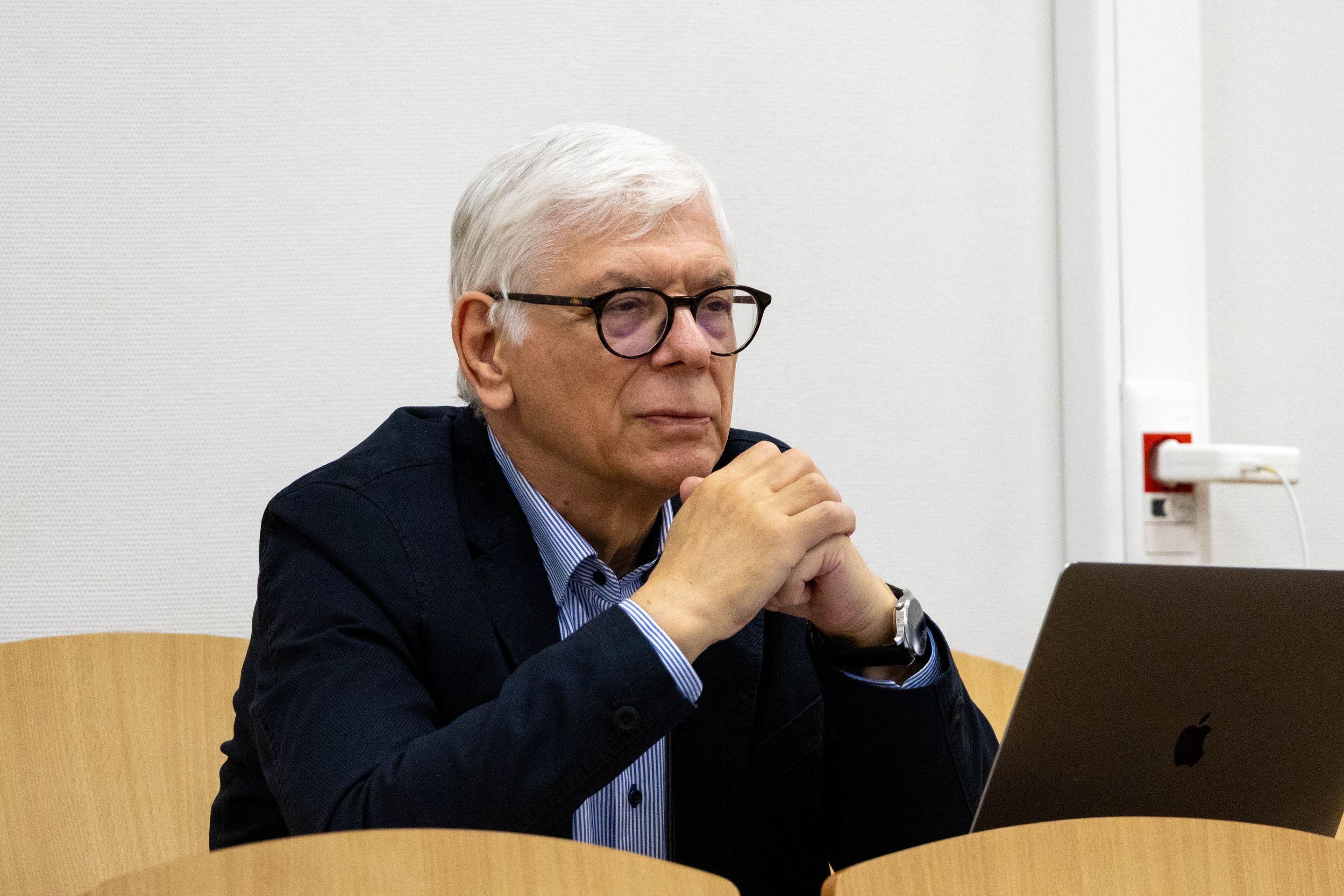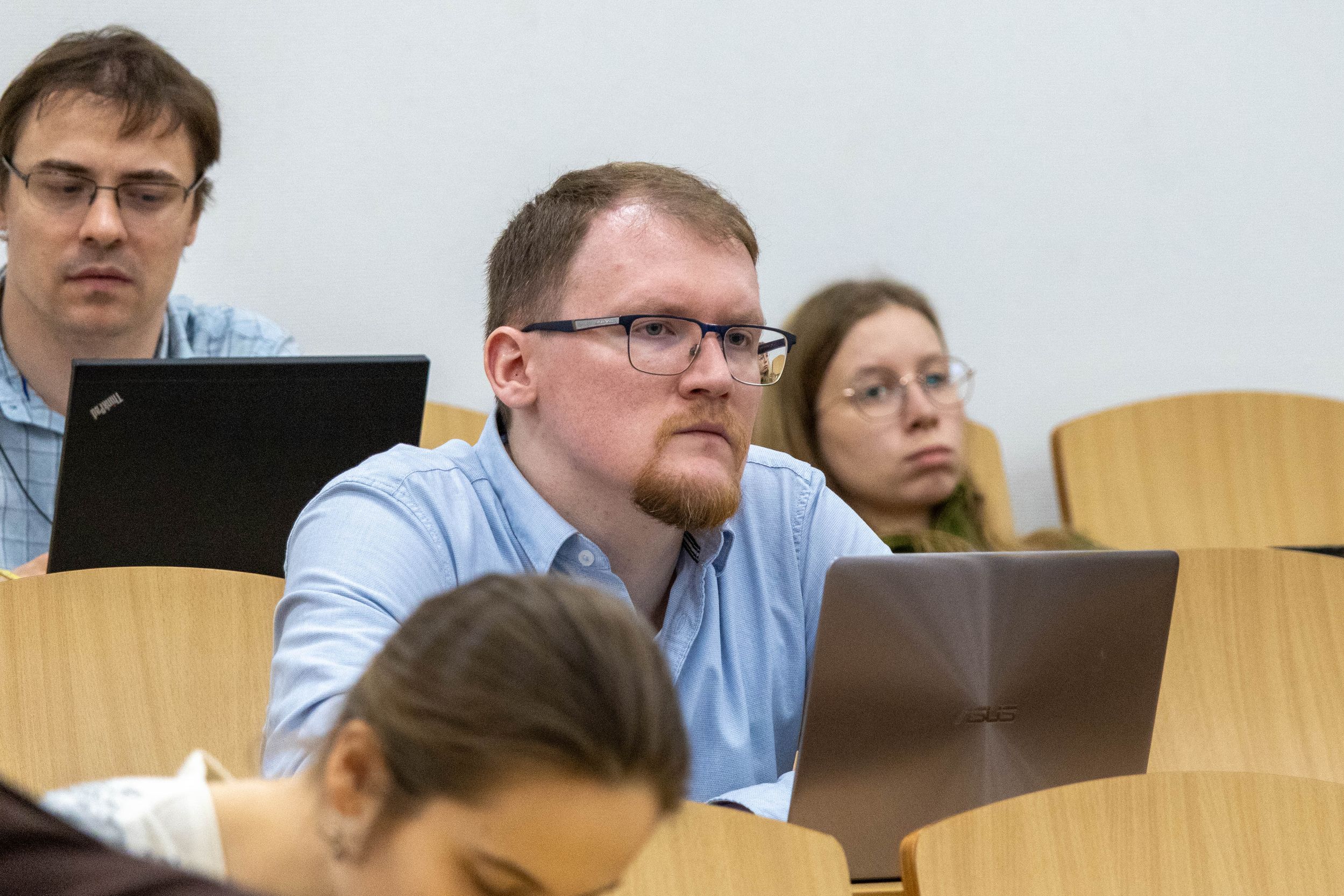'It Was a Great Learning Experience for the New Generation of Mathematicians'

From November 5 to 9, 2024, HSE University hosted a five-day conference on algebraic geometry and mathematical physics, organised jointly with the Beijing Institute of Mathematical Sciences and Applications. Over 30 mathematicians from the world's leading universities, including early-career scientists, participated in the event.
In terms of the quality of basic research, China today is in many ways on par with developed countries, and the Chinese government is making systematic efforts to advance mathematical science. Notably, three years ago, the Beijing Institute of Mathematical Sciences and Applications (BIMSA) was established, bringing together world-renowned scientists from various countries.

Nicolai Reshetikhin
'The development gradient has been positive for at least the past three years, during which I have observed it from the inside,' said conference participant Nicolai Reshetikhin, a prominent American and Russian mathematician currently working at BIMSA. 'China's top universities are undoubtedly serious partners for leading Russian universities. We have much to learn from each other and should create interesting joint projects. This is a wonderful opportunity not to be missed.'
Last summer, HSE University began active collaboration with BIMSA. The first joint event, the Geometry and Physics Conference, was held in Moscow and featured an hour-long presentation by Professor Shing-Tung Yau, the world-renowned mathematician and president of BIMSA. This summer, a workshop was held in Beijing in memory of Igor Krichever who led the Mathematics and Mathematical Physics programme at HSE University, with BIMSA allocating funds towards the event, providing administrative support, and extending invitations to students from Russia.

The conference on algebraic geometry and mathematical physics, hosted by the HSE Faculty of Mathematics from November 5 to 9, was the third major collaborative event between the academic partners. 'This, in fact, was the inaugural conference of “Geometry and Physics,” a new joint research project between the HSE International Laboratory of Mirror Symmetry and Automorphic Forms and BIMSA, conducted as part of HSE University's International Academic Cooperation programme,' according to Valery Gritsenko, Head of the Laboratory.
The conference was held in a hybrid format. Specifically, Shing-Tung Yau and three Fields medallists: Caucher Birkar, Maxim Kontsevich, and Andrei Okounkov—presented online, while 12 Chinese mathematicians came to Moscow. The programme included 33 reports.
'In theoretical mathematics, a report is a concise overview of results that are either entirely new and unpublished or have only recently been released as a preprint. Reflecting the author’s unique perspective, both mathematically and emotionally, this approach helps the audience quickly engage with the research topic. Peer-reviewing a significant result that includes proof of well-known hypotheses can sometimes take over a year, whereas a report is presented here and now,' explains Valery Gritsenko.

A special track of the conference featured 16 presentations by talented early-career mathematicians from Russia and China. Presenting alongside renowned figures in the field was a valuable opportunity for them.
The younger colleagues representing HSE University included Alexey Golota, Research Fellow at the International Laboratory for Mirror Symmetry and Automorphic Forms. His interests lie in algebraic and complex geometry, as well as the application of group theory to geometric problems. He earned his master's from the HSE Faculty of Mathematics in 2019 and his Candidate of Sciences (PhD) degree in 2023. To date, he has published five papers in Russian and international peer-reviewed journals and has presented at numerous international conferences.

'At HSE University's conference, I gave a presentation on the automorphism groups of compact complex homogeneous manifolds,' Alexey said. 'Afterward, I was asked many questions, ranging from the simplest and most basic to very complex ones, where the answers themselves constitute scientific challenges. Of course, I enjoyed listening to presentations by the Fields medallists, but equally fascinating were the reports by early-career mathematicians from BIMSA—potential partners for scientific collaboration.'
According to Alexey Golota, Chinese colleagues have successfully created a favourable environment for productive mathematical studies, and cooperation with them will undoubtedly benefit both partners. 'It seems to me that we should, to some extent, adopt from our colleagues in China their pragmatic and businesslike approach to mathematical work, which is shaped by a highly competitive scientific environment. It may also be beneficial for Chinese colleagues to gain a broader perspective on mathematical problems, which is traditionally characteristic of the Russian mathematical community,' he added.
Xinxing Tang, Associate Professor at BIMSA, was one of the early-career Chinese colleagues who presented at the conference. Her presentation focused on heat kernel analysis and the Calabi-Yau subcategory of Landau-Ginzburg models.
In an interview for the HSE News Service, she shared that over the past 20 years, mathematics in China has developed rapidly—with more mathematical centres and institutes opening, attracting leading international experts. Mathematics education has become a key component of the Chinese government's plan to strengthen basic research. With government support, Shing-Tung Yau founded a college for gifted students aged 11 to 13, and he is confident that he will be able to nurture them into great mathematicians.
'It is well known worldwide that mathematics in Russia is exceptionally strong, and that Russian scientists are the authors of many profound and original ideas and theorems. Their achievements are highly appreciated by Chinese colleagues. During my doctoral studies, I often heard about Russian mathematical seminars—for example, that they are really long and feature heated discussions,’ Xinxing Tang said.
She added that the conference in Moscow was a great opportunity to meet new people, participate in discussions, and share the results of her work and scientific ideas. The discussions were engaging and diverse, and it was a pleasure to see many younger speakers. If any organisational or technical issues arose, the organisers at HSE University addressed them promptly and efficiently. Xinxing Tan also praised the high quality of the tea served to the conference participants.
Summing up the results of the five-day event, Valery Gritsenko emphasised that the presentations covered a vast amount of scientific material that warrants further reflection and creative exploration. 'It was a great learning experience for the new generation. The presentations by world-renowned scientific authorities, along with 16 half-hour talks by younger participants, provided a comprehensive overview of the new wave of mathematics,' he concluded.
See also:
HSE University Wins Seven Medals at International Mathematics Competition for University Students
HSE students were among the winners of the International Mathematics Competition for University Students (IMC), which was held in August in Bulgaria. The medallists are students of the HSE Faculty of Computer Science (FCS) programme in Applied Mathematics and Information Science and the Faculty of Mathematics programme in Mathematics.
‘Our Result Was Recognised Not Only Within the Project Defence but Also on International Scale’
This year, the European AI Conference (ECAI 2025) accepted an article titled ‘Multi-Agent Path Finding for Large Agents is Intractable’ by Artem Agafonov, a second-year student of the Applied Mathematics and Information Science Bachelor’s programme at HSE University’s Faculty of Computer Science. The work was co-authored by Konstantin Yakovlev, Head of the Joint Department with Intelligent Technologies of System Analysis and Management at the Federal Research Centre ‘Informatics and Management’ of the RAS and Associate Professor at the Faculty of Applied Sciences. In the interview, Artem Agafonov explained how he came up with the idea for the article and how he was able to present it at an A-level conference.
'Today, Human Existence Without Mathematics Is Difficult; Tomorrow, It Will Be Simply Impossible'
Mathematicians around the world share a common language and continue to collaborate despite the challenges of recent years. The hub of mathematical networking has been shifting to China, where scientists from various countries meet at conferences and other academic events. Partnerships with leading Chinese universities offer promising opportunities to strengthen existing ties and forge new ones. In this interview with the HSE News Service, Valery Gritsenko, Head of the HSE International Laboratory for Mirror Symmetry and Automorphic Forms, discusses this and other topics, including what AI is and why the state should engage with mathematicians.
HSE Scores Best Results among Russian Universities at International Olympiad in Uzbekistan
At the Third Al-Khorezmi International Mathematical Olympiad (AKHIMO), held at Urgench State University in Uzbekistan, students from HSE University's Faculty of Computer Science scored best results among participants from Russian universities. The olympiad also featured contestants from Brazil, the USA, China, India, South Korea, Malaysia, Japan, Vietnam, Serbia, Kyrgyzstan, Kazakhstan, Tajikistan, Turkey, Turkmenistan, and Uzbekistan.
Russian Scientists Assess Dangers of Internal Waves During Underwater Volcanic Eruptions
Mathematicians at HSE University in Nizhny Novgorod and the A.V. Gaponov-Grekhov Institute of Applied Physics of the Russian Academy of Sciences studied internal waves generated in the ocean after the explosive eruption of an underwater volcano. The researchers calculated how the waves vary depending on ocean depth and the radius of the explosion source. It turns out that the strongest wave in the first group does not arrive immediately, but after a significant delay. This data can help predict the consequences of eruptions and enable advance preparation for potential threats. The article has been published in Natural Hazards. The research was carried out with support from the Russian Science Foundation (link in Russian).
'The Six Handshakes Rule Applies to Social Media'
Ivan Samoylenko specialises in graph theory; in his third year of university, he developed an idea that later became the foundation of a highly cited academic article. In this interview with the HSE Young Scientists project, he speaks about the Watts-Strogatz small-world model, being a performer in the Bolshoi Children's Choir, and making the choice between science and industry.
‘HSE Is a Very Good Place: Intelligent Students, a Strong Teaching Staff’
Since March 2025, the HSE Faculty of Mathematics has welcomed a leading Russian mathematician, Doctor of Physical and Mathematical Sciences, Honorary Professor at the University of Edinburgh, National Professor of China, and recipient of the Lyapunov Prize—Sergey Kuksin. In an interview with the HSE News Service, he spoke about the role of the individual in mathematics, KAM theory, and why analysis is so relevant today.
Scientists Disprove Bunkbed Conjecture
Mathematicians from Russia, including two HSE graduates, have disproven a well-known mathematical conjecture that, despite lacking solid proof, had been considered valid for 40 years. The ‘Bunkbed Conjecture’ belongs to percolation theory—a branch of mathematics that studies the formation of connected structures in independent environments.
'Our Mathematics Is for Far-Reaching Minds'
Anna Presnova focuses on automatic control theory, a branch of science that addresses global problems. In this interview with the HSE Young Scientists project, she talks about her aspiration to achieve practical results, the energy she gains from teaching, and why she would be interested to meet with Alexandr Lyapunov, founder of stability theory.
HSE University Wins Two Medals at the International Mathematics Competition for University Students
Two students, one graduate and one undergraduate, from the HSE Faculty of Computer Science (FCS) programme in ‘Applied Mathematics and Information Science’ won prestigious awards at the International Mathematics Competition for University Students (IMC). Graduate Maksim Kazadaev and first-year student Daria Linichenko both represented HSE University at the IMC, winning gold and silver medals respectively.


